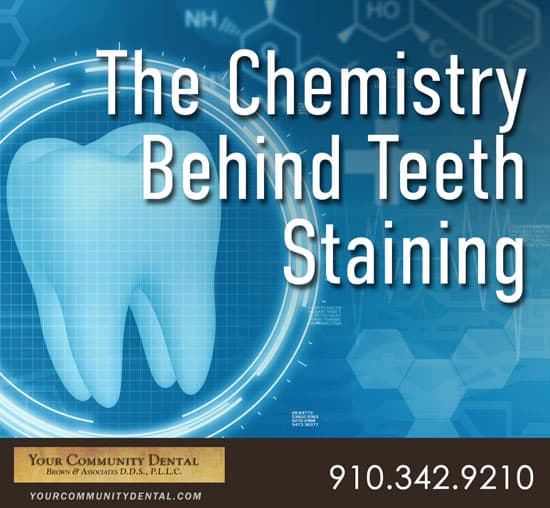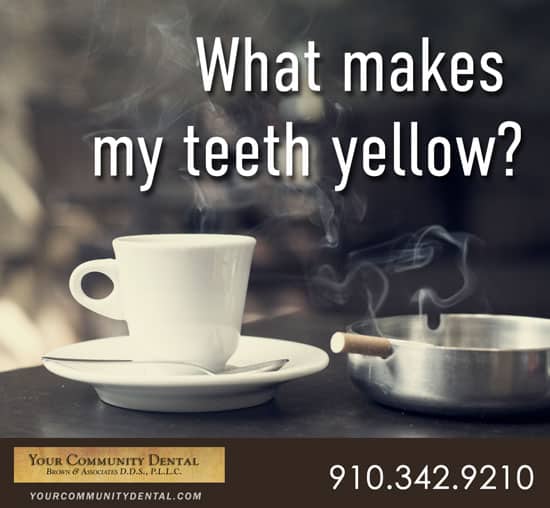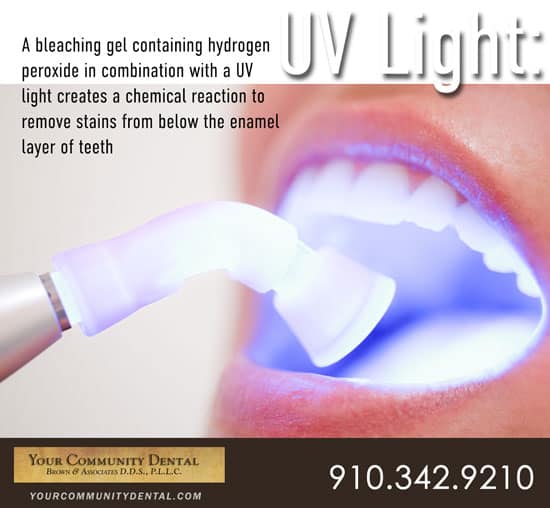The Chemistry Behind Teeth Staining

Sometimes it feels like you are simply born with a yellowed smile, while others are gifted with bright, pearly whites from the start. Have you considered that this might be somewhat true? While some teeth staining comes from genetics making you more susceptible, there is also a pretty complex science behind why your teeth become stained. Before you look into how to whiten your teeth, let’s dive into why your teeth stain in the first place.
First things first! What are teeth even made of?
The outer layer of the tooth is made of crystalline calcium phosphate, or just “enamel” as it is most commonly called. This mineral is very strong, somewhat translucent, and porous. Underneath the layer of enamel is dentin, a slightly softer substance that makes up the majority of your tooth. Dentin is more yellow in color, and this color is what comes through when enamel has eroded or teeth are not clean. Although enamel is the hardest tissue in the human body, it does not contain collagen and therefore once enamel formation is over, the tooth cannot form more enamel.
What makes my teeth yellow?

There are actually two types of teeth staining: intrinsic and extrinsic. Intrinsic stains occur on the inner structure of the tooth, and extrinsic stains occur on the outside of the tooth. Determining what type of teeth staining you have is the key to finding a whitening treatment that works for you. A brighter, more attractive smile is definitely not out of reach!
Extrinsic staining:
Extrinsic staining happens because of the structure of tooth enamel. The enamel on the outside of your teeth becomes stained from food, drinks, or smoking.
How do my teeth get extrinsic staining?
Eating certain foods can cause a layer called the “pellicle” to form on top of the enamel. Pellicle, or the stain, can be scraped away at by a dentist or by a toothbrush. However, because the enamel is porous, the stain can seep into the dentin if pellicle remains sitting on top of the tooth for too long. Coffee, wine, tea, soft drinks, and a number other food and drinks can stain teeth. Smoking and tobacco products also cause extrinsic stains.
If your saliva flow is lower than normal, you are more susceptible to extrinsic staining. Saliva helps break down food debris and if saliva flow is low, food particles remain in the mouth longer and have more time to increase potential teeth staining.
Intrinsic staining:
Your teeth can also become discolored by changes inside of the tooth. Intrinsic stains can be caused by damage to a nerve canal or blood vessel. The inner structure, or the dentin of the tooth, darkens or forms a yellow tint. Sometimes, materials used for dental fillings or traumatic tooth injuries can alter tooth color.
How do my teeth get intrinsic staining?
- Too much fluoride exposure during early childhood
- Mothers consuming tetracycline antibiotics during the second half of pregnancy
- Children who use tetracycline antibiotics when they are 8 years old or younger
- Tooth trauma as a child interfering with a developing permanent tooth
- Trauma in a permanent tooth and internal bleeding discoloring the tooth
Age-related staining:
Over time, dentin naturally yellows, so age-related staining is a combination of extrinsic and intrinsic factors. As enamel becomes thinner with age, the yellowish dentin starts to show through. Any chips or teeth injuries can discolor a tooth as well.
Symptoms and Diagnosis:
The symptom of staining is pretty simple to identify if a stain is on the enamel. Extrinsic stains can range from white streaks, yellow tints, or even brown spots and pits. Intrinsic stains, when the enamel has worn away and the dentin shows through, will show a yellow tint.
Typically, patients notice their smile’s discoloration but any dental professional can diagnose teeth staining. The benefit of getting your dentist’s opinion is that they can identify how your teeth were stained and provide you with a professional preventative and treatment plan.
How can I prevent teeth staining?
We recommend you start healthy dental practices early and schedule dental visits twice-yearly. Regular cleanings and teeth polishing by a hygienist will help remove surface stains. Making sure that you brush your teeth after every meal with fluoride toothpaste will certainly help prevent some stains, as well as flossing daily.
Some minor lifestyle changes can make a big difference in the color of your teeth. Avoiding or limiting food known to stain or quitting the use of any tobacco will help reduce mild staining. If you know you’re going to be drinking wine, coffee, or other hard-staining food and drink, brush your teeth beforehand and rinse out your mouth with water immediately afterward.
Intrinsic staining is a bit harder to prevent. Because they typically occur due to tooth trauma, early fluoride use, or early use of antibiotics. Intrinsic teeth staining is usually treated rather than prevented.
If you are worried about intrinsic stains on children’s teeth, avoid early exposure to fluoride. Professional dental visits early on will ensure that your dentist will schedule regular cleanings, and monitor age-appropriate fluoride treatments. After enamel is fully formed, fluoride does not harm your teeth’s enamel.
Dirty mouth? You’re going to need more than chewing gum!
If you’re teeth are stained, there are luckily a number of treatment options to fit individual patient’s needs. It is also important to note that tooth discoloration is mainly a cosmetic problem for adults.
Treating extrinsic stains:
Whitening toothpaste:
Whitening toothpaste only removes minor stains, and does not actually change the color of your teeth.
Related: Charcoal Toothpaste, Yes or No?
Teeth whitening strips:
Over-the-counter teeth whitening strips are similar to whitening toothpaste; the whitening product is not very strong or specifically formed to fit your teeth, and only remove temporary stains.
Bleaching Gel:
Bleaching gel is a common whitening treatment that doesn’t require major lifestyle changes. With bleaching agents and a mouth guard, bleaching your teeth to whiten them is a great, quick option to discuss with your dentist. In a professional application, the bleaching agents result in brighter teeth after just one session and last a year or more if you take preventative measures to limit staining food and drinks, and practice healthy hygiene practices.
You can technically bleach your teeth from home, but the bleaching agents are not going to be as strong as a treatment you can get from your dentist. Home whitening kits are weaker, take several weeks to see results, and fade faster. Beware that if you bleach from home, be careful not to get the gel on your gums. Your gums are made of soft tissue that is susceptible to burns.
Treating intrinsic stains:
Intrinsic stains usually require a professional to treat and may be more difficult or take longer to remove. Only a dental professional can treat an intrinsically discolored tooth. A professional should evaluate the change if children are experiencing discoloration from their normal tooth color.

UV Light:
A bleaching gel containing hydrogen peroxide in combination with a UV light creates a chemical reaction to remove stains from below the enamel layer of teeth. The hydrogen peroxide enters the tooth and releases free radicals to break down the stain beneath the enamel. As the free radicals break down, the yellow color starts to disappear. Adding UV light to the treatment accelerates this chemical process. Although this requires you sitting with your mouth open with UV lights on your teeth for 30 minutes to an hour, it’s usually a one-time treatment to see impressive results.
Cosmetic restorations:
A porcelain veneer permanently bonded to the front of the tooth can cover heavily stained or discolored teeth. Veneers are made to match the patient’s normal tooth color and mask the stains of the underlying tooth. Veneers do not stain but your natural teeth can, so you may still need whitening treatments to maintain a balanced color.
Ready to talk about ensuring you have bright, pearly whites?
At Your Community Dental, we are always ready to talk about your smile. If you’re feeling embarrassed about your smile or your teeth just aren’t as white as you would like them to be, then it might be time to visit your dentist.
Consulting a trusted professional cannot be stressed enough! Seeing a dental professional can be the differences between unnecessary expenses and disappointment from trying at-home whitening kits or experimenting with treatments that just aren’t suitable for the type of staining on your teeth. If you’re concerned about teeth staining, visit your dentist and start by identifying whether your teeth discoloration comes from extrinsic or intrinsic staining.
We encourage you to contact and schedule an appointment with Your Community Dental today. We will ensure you know all the facts and help you make the right choice to brighten your smile.
